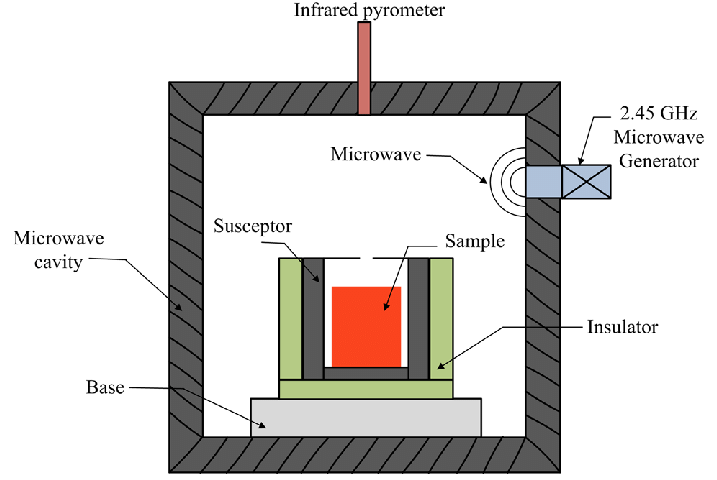Ceramic substrates are essential materials in industries such as electronics, semiconductors, and optoelectronics. They are widely used in electronic components. The manufacturing process of ceramic substrates is complex, with the sintering process playing a crucial role. Sintering involves heating ceramic powders to a high temperature, causing particles to bond together, forming a dense, hard ceramic substrate. Depending on the material characteristics and application requirements, there are various sintering processes, each affecting the final product’s performance, cost, and production efficiency.
1. Overview of Sintering Processes
Sintering is a key process in the production of ceramic substrates. It involves heating ceramic powders, causing the particles to diffuse, melt, or bond through various mechanisms, ultimately forming a dense ceramic material. The temperature, pressure, and atmosphere used during sintering can significantly affect the substrate’s density, strength, thermal conductivity, and electrical properties.
Based on factors such as whether external pressure is applied or if special atmospheres are used, sintering processes can be classified into several types:
- Solid-State Sintering
- Pressure Sintering
- Hot Pressing
- Hot Isostatic Pressing (HIP)
- Microwave Sintering
- Liquid Phase Sintering
- Atmosphere Sintering
Each sintering process has its own characteristics, influencing the final properties and cost of ceramic substrates. Selecting the right sintering process is crucial for ensuring the quality of the product.
2. Solid-State Sintering
Process Features:
Solid-state sintering is the most common sintering method. It involves heating ceramic powders to high temperatures, causing particles to bond through diffusion, without the application of external pressure. This process relies on atomic or ionic diffusion between ceramic particles to form a cohesive structure.
Application in Ceramic Substrates:
Solid-state sintering is widely used for producing common ceramic substrates such as aluminum oxide (alumina) and titanium ceramic substrates. This method is cost-effective, making it suitable for large-scale production. However, it may result in some porosity, which can affect the quality of the ceramic substrate.

3. Pressure Sintering
Process Features:
Pressure sintering involves applying external pressure during the sintering process to promote particle bonding. The pressure can be either static or dynamic. The application of pressure accelerates the densification of the ceramic particles, reducing porosity and increasing the density and strength of the final product.
Application in Ceramic Substrates:
Pressure sintering is used for producing ceramic substrates with high density and performance requirements, such as high-performance electronic ceramics. It significantly improves thermal conductivity, electrical insulation, and strength, making it suitable for substrates in high-power or thermally demanding electronic applications.

4. Hot Pressing
Process Features:
Hot pressing is a sintering method where pressure is applied simultaneously with heating, allowing the ceramic particles to densify rapidly at relatively lower temperatures. This process combines heat and pressure to accelerate the sintering process, enabling quick formation of dense ceramic materials.
Application in Ceramic Substrates:
Hot pressing is particularly suitable for ceramic substrates that require high strength and thermal conductivity. It is commonly used in the production of substrates for high-frequency electronic components. In industries such as aerospace and optoelectronics, where high material performance is essential, hot pressing provides an ideal solution.

5. Hot Isostatic Pressing (HIP)
Process Features:
Hot isostatic pressing (HIP) involves placing ceramic material in a sealed chamber and applying high temperature and uniform pressure using a gas, such as argon. This process eliminates defects caused by uneven pressure, significantly improving the density and strength of the ceramic material.
Application in Ceramic Substrates:
HIP is widely used in the production of ceramic substrates that require extremely high density and reliability. It ensures that the ceramic substrate is free from voids or microcracks, improving both its mechanical and electrical properties. This process is particularly useful for producing high-performance electronic substrates and semiconductor packaging materials.

6. Microwave Sintering
Process Features:
Microwave sintering uses microwaves to directly heat the ceramic material, causing rapid molecular vibration and efficient sintering. Compared to conventional heating methods, microwave sintering offers faster heating, uniform temperature distribution, and high energy efficiency.
Application in Ceramic Substrates:
Microwave sintering is ideal for producing high-performance ceramic substrates that require high-frequency or high-power handling. It improves precision and consistency, shortens production cycles, and reduces energy consumption. This method is increasingly used in the production of electronic substrates for modern high-frequency devices.

7. Liquid Phase Sintering
Process Features:
Liquid phase sintering involves the presence of a liquid phase during sintering, which aids the bonding of ceramic particles through diffusion. This process allows for higher density sintering at lower temperatures, making it suitable for producing high-performance ceramics.
Application in Ceramic Substrates:
Liquid phase sintering is commonly used for producing advanced ceramic substrates that require high density, strength, and thermal conductivity. It enhances the overall performance of ceramic substrates, particularly in applications that demand high thermal management and electrical isolation.

8. Atmosphere Sintering
Process Features:
Atmosphere sintering is performed in a controlled atmosphere, such as oxygen, nitrogen, or hydrogen. The atmosphere affects the chemical reactions occurring during sintering, impacting the final properties of the ceramic material.
Application in Ceramic Substrates:
Atmosphere sintering is used for various types of ceramic substrates, especially when the goal is to avoid oxidation or reduce porosity. By controlling the atmosphere, manufacturers can optimize the sintering process and ensure the quality of the final ceramic substrate.

Conclusion
In the production of ceramic substrates, choosing the appropriate sintering process is crucial for improving product performance and reducing production costs. Each sintering method has unique advantages and limitations, and manufacturers must select the most suitable one based on the specific requirements of the product, such as thermal conductivity, strength, density, and dimensional accuracy. For ceramic substrate manufacturers, especially those operating independent trade websites, understanding the characteristics and applications of different sintering processes will help optimize production, enhance product competitiveness, and meet the growing global demand for high-performance electronic substrates.





